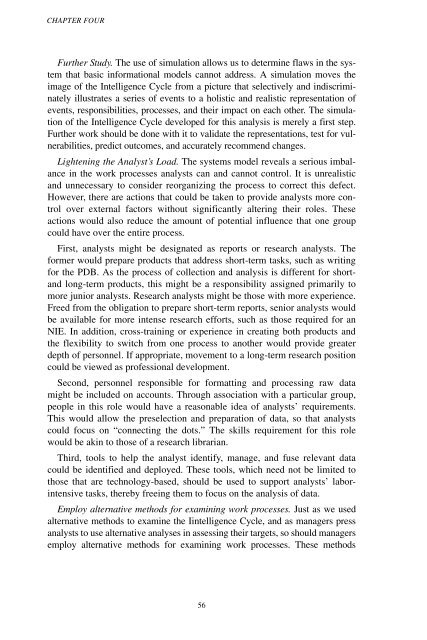Analytic Culture in the U.S. Intelligence Community (PDF) - CIA
Analytic Culture in the U.S. Intelligence Community (PDF) - CIA
Analytic Culture in the U.S. Intelligence Community (PDF) - CIA
Create successful ePaper yourself
Turn your PDF publications into a flip-book with our unique Google optimized e-Paper software.
CHAPTER FOUR<br />
Fur<strong>the</strong>r Study. The use of simulation allows us to determ<strong>in</strong>e flaws <strong>in</strong> <strong>the</strong> system<br />
that basic <strong>in</strong>formational models cannot address. A simulation moves <strong>the</strong><br />
image of <strong>the</strong> <strong>Intelligence</strong> Cycle from a picture that selectively and <strong>in</strong>discrim<strong>in</strong>ately<br />
illustrates a series of events to a holistic and realistic representation of<br />
events, responsibilities, processes, and <strong>the</strong>ir impact on each o<strong>the</strong>r. The simulation<br />
of <strong>the</strong> <strong>Intelligence</strong> Cycle developed for this analysis is merely a first step.<br />
Fur<strong>the</strong>r work should be done with it to validate <strong>the</strong> representations, test for vulnerabilities,<br />
predict outcomes, and accurately recommend changes.<br />
Lighten<strong>in</strong>g <strong>the</strong> Analyst’s Load. The systems model reveals a serious imbalance<br />
<strong>in</strong> <strong>the</strong> work processes analysts can and cannot control. It is unrealistic<br />
and unnecessary to consider reorganiz<strong>in</strong>g <strong>the</strong> process to correct this defect.<br />
However, <strong>the</strong>re are actions that could be taken to provide analysts more control<br />
over external factors without significantly alter<strong>in</strong>g <strong>the</strong>ir roles. These<br />
actions would also reduce <strong>the</strong> amount of potential <strong>in</strong>fluence that one group<br />
could have over <strong>the</strong> entire process.<br />
First, analysts might be designated as reports or research analysts. The<br />
former would prepare products that address short-term tasks, such as writ<strong>in</strong>g<br />
for <strong>the</strong> PDB. As <strong>the</strong> process of collection and analysis is different for shortand<br />
long-term products, this might be a responsibility assigned primarily to<br />
more junior analysts. Research analysts might be those with more experience.<br />
Freed from <strong>the</strong> obligation to prepare short-term reports, senior analysts would<br />
be available for more <strong>in</strong>tense research efforts, such as those required for an<br />
NIE. In addition, cross-tra<strong>in</strong><strong>in</strong>g or experience <strong>in</strong> creat<strong>in</strong>g both products and<br />
<strong>the</strong> flexibility to switch from one process to ano<strong>the</strong>r would provide greater<br />
depth of personnel. If appropriate, movement to a long-term research position<br />
could be viewed as professional development.<br />
Second, personnel responsible for formatt<strong>in</strong>g and process<strong>in</strong>g raw data<br />
might be <strong>in</strong>cluded on accounts. Through association with a particular group,<br />
people <strong>in</strong> this role would have a reasonable idea of analysts’ requirements.<br />
This would allow <strong>the</strong> preselection and preparation of data, so that analysts<br />
could focus on “connect<strong>in</strong>g <strong>the</strong> dots.” The skills requirement for this role<br />
would be ak<strong>in</strong> to those of a research librarian.<br />
Third, tools to help <strong>the</strong> analyst identify, manage, and fuse relevant data<br />
could be identified and deployed. These tools, which need not be limited to<br />
those that are technology-based, should be used to support analysts’ labor<strong>in</strong>tensive<br />
tasks, <strong>the</strong>reby free<strong>in</strong>g <strong>the</strong>m to focus on <strong>the</strong> analysis of data.<br />
Employ alternative methods for exam<strong>in</strong><strong>in</strong>g work processes. Just as we used<br />
alternative methods to exam<strong>in</strong>e <strong>the</strong> I<strong>in</strong>telligence Cycle, and as managers press<br />
analysts to use alternative analyses <strong>in</strong> assess<strong>in</strong>g <strong>the</strong>ir targets, so should managers<br />
employ alternative methods for exam<strong>in</strong><strong>in</strong>g work processes. These methods<br />
56
















